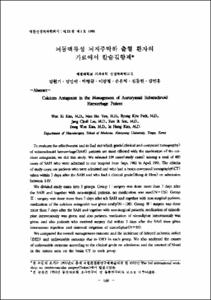KUMEL Repository
1. Journal Papers (연구논문)
1. School of Medicine (의과대학)
Dept. of Neurosurgery (신경외과학)
뇌동맥류성 뇌지주막하 출혈 환자의 가료에서 칼슘길항제
- Keimyung Author(s)
- Yim, Man Bin; Lee, Jang Chull; Son, Eun Ik; Kim, Dong Won; Kim, In Hong
- Department
- Dept. of Neurosurgery (신경외과학)
- Journal Title
- 대한신경외과학회지
- Issued Date
- 1993
- Volume
- 22
- Issue
- 2
- Abstract
- To evaluate the effectiveness and to find out which grade(clinical and computed tomography) of subarachnoid hemorrhage(SAH) patients are most effected with the mediation of the calcium antagonist, we did this study. We selected 339 cases(study cases) among a total of 603 cases of SAH who were admitted to our hospital from Sept. 1982 to April 1991. The criteria of study cases are patients who were admitted and who had a brain computed tomography(CT) taken within 3 days after the SAH and who had a clinical grade(Hung & Hess) on admission between Ⅰ-Ⅳ.
We divided study cases into 3 groups, Group Ⅰ : surgery was done more than 7 days after the SAH and together with non-surgical patients, no medication was used(N=126). Group Ⅱ : surgery was done more than 7 days after the SAH and together with non-surgical patients, medication of the calcium antagonist was given orally(N=120). Group Ⅲ : surgery was done more than 7 days after the SAH and together with non-surgical patients, medication of nimodipine intravenously was given, and also patients, medication of nimodipine intravenously was given, and also patients who received surgery did within 3 days after the SAH were given intravenous injection and cisternal irrigation of nimodipine(N=93).
We compared the overall management outcome and the incidence of delayed ischemic deficit(DID) and unfavorable outcome due to DID in each group. We also analyzed the causes of unfavorable outcome according to the clinical grade on admission and the amount of blood in the cistern seen on the brain CT in each group.
The results of this study showed that overall management outcome was improved by using the calcium antagonist. The calcium antagonist reduced the incidence of DID as well as the unfavorable outcome related to DID.
In clinical grade Ⅲ patients on admission, the unfavorable outcome due to DID was significantly lower in group Ⅱ and Ⅲ than in Ⅰ(group Ⅰ vs. Ⅱ : p<0.05, group Ⅰ vs. Ⅲ : p<0.01). In cases with a large amount of blood in the cistern seen on the brain CT, the unfavorable outcome was significantly lower in groupsⅡ and Ⅲ than in Ⅰ(group Ⅰ vs. Ⅱ : p<0.01, group Ⅰ vs. Ⅲ : p<0.05).
We conclude that the overall management outcome of aneurysmal SAH patients may be improved by using a calcium antagonist and the effect of the calcium antagonist is prominent in clinical grade Ⅲ patients on admission and patients with a large amounts of blood in the cistern seen on the brain CT.
저자들은 과거 9년간 본원에 뇌동맥류성 지주막하 출혈로 입원 가료한 608례중 889례를 선택하여 칼슘길항제가 전체환자의 가료 성적을 향상 시키는지의 여부, 임상적 및 CT상 어떤 소견을 보이는 예들에서 그 효과가 현저한지, 또한 뇌혈관 연축에 기인한 뇌허혈 중상의 발현 빈도 및 이에 기인한 중등도 이상의 장애 및 사망예들의 빈도를 감소시키는지에 대하여 조사하였다. 결과는 칼슘길항제를 사용하므로써 전체환자의 가료 성적, 뇌혈관 연축에 기인한 뇌허혈 증상의 발현 빈도 및 이에 기인한 중등도 이상의 장애 및 사망예들의 빈도를 감소시키는 경향을 보였고 특히 임상등급 Ⅲ 및 CT상 뇌지주막하 출혈이 심한 예들에서 유의하게 그러하였다. 따라서 뇌동맥류성 지주막하 출혈 환자의 가료에서 nimodipine의 사용은 의의가 있을 것으로 사료되고 특히 임상상태가 중한 환자 및 CT상 뇌지주막하 출혈이 심한 환자들에서 그 효과가 클것으로 사료된다.
- Alternative Title
- Calcium Antagonist in the Management of Aneurysmal Subarachnoid Hemorrhage Patient
- Publisher
- School of Medicine
- Citation
- 김원기 et al. (1993). 뇌동맥류성 뇌지주막하 출혈 환자의 가료에서 칼슘길항제. 대한신경외과학회지, 22(2), 169–179.
- Type
- Article
- ISSN
- 1225-8245
- Appears in Collections:
- 1. School of Medicine (의과대학) > Dept. of Neurosurgery (신경외과학)
- 파일 목록
-
-
Download
 oak-bbb-1637.pdf
기타 데이터 / 563.8 kB / Adobe PDF
oak-bbb-1637.pdf
기타 데이터 / 563.8 kB / Adobe PDF
-
Items in Repository are protected by copyright, with all rights reserved, unless otherwise indicated.